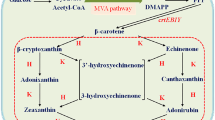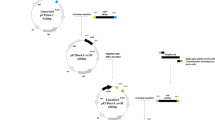Abstract
Natural β-carotene has received much attention as consumers have become more health conscious. Its production by various microorganisms including metabolically engineered Escherichia coli or Saccharomyces cerevisiae has been attempted. We successfully created a recombinant E. coli with an engineered whole mevalonate pathway in addition to β-carotene biosynthetic genes and evaluated the engineered cells from the aspects of metabolic balance between central metabolism and β-carotene production by comparison with conventional β-carotene producing recombinant E. coli (control) utilizing a native methylerythritol phosphate (MEP) pathway using bioreactor cultures generated at different temperatures or pHs. Better production of β-carotene was obtained in E. coli cultured at 37°C than at 25°C. A two-fold higher titer and 2.9-fold higher volumetric productivity were obtained in engineered cells compared with control cells. Notably, a marginal amount of acetate was produced in actively growing engineered cells, whereas more than 8 g/L of acetate was produced in control cells with reduced cell growth at 37°C. The data indicated that the artificial operon of the whole mevalonate pathway operated efficiently in redirecting acetyl-CoA into isopentenyl pyrophosphate (IPP), thereby improving production of β-carotene, whereas the native MEP pathway did not convert a sufficient amount of pyruvate into IPP due to endogenous feedback regulation. Engineered cells also produced lycopene with a reduced amount of β-carotene in weak alkaline cultures, consistent with the inhibition of lycopene cyclase.
Similar content being viewed by others
References
Burri, B. J. (1997) Beta-carotene and human health: A review of current research. Neutri. Res. 17: 547–580.
Jaramillo-Flores, M. E., J. J. Lugo-Martinez, E. Ramirez-Sanjuan, H. Montellano-Rosales, L. Dorantes-Alvarez, and H. Hernandez-Sanchez (2005) Effect of sodium chloride, acetic acid, and enzymes on carotene extraction in carrots (Daccus carota L.). J. Food Sci. 70: 136–142.
Garcia-Gonzalez, M., J. Moreno, J. C. Manzano, F. J. Florencio, and M. G. Guerrero (2005) Production of Dunaliella salina biomass rich in 9-cis-β-carotene and lutein in a closed tubular photobioreactor. J. Biotechnol. 115: 81–90.
Kim, S. -W., J. -B. Kim, W. -H. Jung, J. -H. Kim, and J. -K. Jung (2006) Over-production of β-carotene from metabolically engineered Escherichia coli. Biotechnol. Lett. 28: 897–904.
Mantzouridou, F., T. Roukas, and P. Kotzekidou (2005) Production of beta-carotene from synthetic medium by Blakeslea trispora in fed-batch culture. Food Biotechnol. 18: 343–361.
Malisorn, C. and W. Suntornsuk (2008) Optimization of β-carotene production by Rhodotorula glutinis DM28 in fermented radish brine. Biores. Technol. 99: 2281–2287.
Saenge, C., B. Cheirsilp, T. T. Suksaroge, and T. Bourtoom (2011) Efficient concomitant production of lipids and carotenoids by oleaginous red yeast Rhodotorula glutinis cultured in palm oil mill effluent and application of lipids for biodiesel production. Biotechnol. Bioproc. Eng. 16: 23–33.
Verwaal, R., J. Wang, J. -P. Meijnen, H. Visser, G. Sandmann, J. A. V. D. Berg, and A. J. J. V. Ooyen (2007) High-level production of beta-carotene in Saccharomyces cerevisiae by successive transformation with carotenogenic genes from Xanthophyllomyces dendrorhous. Appl. Environ. Microbiol. 73: 4342–4350.
Yoon, S. -H, S. -H. Lee, A. Das, H. -K. Ryu, H. -J. Jang, J. -Y. Kim, D. -K. Oh, J. D. Keasling, and S. -W. Kim (2009) Combinatorial expression of bacterial whole mevalonate pathway for the production of β-carotene in E. coli. J. Biotechnol. 140: 218–226.
Kim, J. H., S. -W. Kim, D. Q. A. Nguyen, H. Li, S. B. Kim, Y. -G. Seo, J. -K. Yang, I. -Y. Chung, D. H. Kim, and C. -J. Kim (2009) Production of β-carotene by recombinant Escherichia coli with engineered whole mevalonate pathway in batch and fed-batch cultures. Biotechnol. Bioproc. Eng. 14: 559–564.
Das, A., S. -H. Yoon, S. -H. Lee, J. -Y. Kim, D. -K. Oh, and S. -W. Kim (2007) An update on microbial carotenoid production: Application of recent metabolic engineering tools. Appl. Micro-biol. Biotechnol. 77: 505–512.
Eiteman, M. A. and E. Altman (2006) Overcoming acetate in Escherichia coli recombinant protein fermentations. Trends Biotechnol. 24: 530–536.
Selvarasu, S., D. S. -W. Ow, S. Y. Lee, M. M. Lee, S. K. -W. Oh, I. A. Karimi, and D. -Y. Lee (2009) Characterizing Escherichia coli DH5α growth and metabolism in a complex medium using genome-scale flux analysis. Biotechnol. Bioeng. 102: 923–934.
Vemuri, G. N., T. A. Mining, E. Altman, and M. A. Eiteman (2005) Physiological response of central metabolism in Escherichia coli to deletion of pyruvate oxidase and introduction of heterologous pyruvate carboxylase. Biotechnol. Bioeng. 90: 64–76.
Won, W., C. Park, C. Park, S. Y. Lee, K. S. Lee, and J. Lee (2011) Parameter estimation and dynamic control analysis of central carbon metabolism in Escherichia coli. Biotechnol. Bioproc. Eng. 16: 216–228.
Martin, V. J. J., D. J. Pitera, S. T. Withers, J. D. Newman, and J. D. Keasling (2003) Engineering a mevalonate pathway in Escherichia coli for production of terpenoids. Nat. Biotechnol. 21: 796–802.
Pitera, D. J., C. J. Paddon, J. D. Newman, and J. D. Keasling (2007) Balancing a heterologous mevalonate pathway for improved isoprenoid production in Escherichia coli. Metab. Eng. 9: 193–207.
Sambrook, J. and D. W. Russel (2010) Molecular Cloning: A Laboratory Manual. 3rd ed. Cold Spring Harbor Laboratory Press, Cold Spring Harbor, NY, USA.
Schierle, J., B. Pietsch, A. Ceresa, and C. Fizet (2004) Method for the determination of β-carotene in supplements and raw materials by reversed-phase liquid chromatography: Single laboratory validation. J. AOAC Int. 87: 1070–1082.
Torrecilla, J. S., M. Camara, V. Fernandez-Ruiz, G. Piera, and J. O. Caceres (2008) Solving the spectroscopy interference effects of β-carotene and lycopene by neural networks. J. Agric. Food. Chem. 56: 6261–6266.
Sandmann, G., M. Albrecht, G. Schnurr, O. Knorzer, and P. Boger (1999) The biotechnological potential and design of novel carotenoids by gene combination in Escherichia coli. Trends Biotechnol. 17: 233–237.
Vemuri, G. N., E. Altman, D. P. Sangurdekar, A. B. Khodursky, and M. A. Eiteman (2006) Overflow metabolism in Escherichia coli during steady-state growth: Transcriptional regulation and effect of redox ratio. Appl. Env. Microbiol. 72: 3653–3661.
Mey, M. D., S. D. Maeseneire, W. Soetaert, and E. Vandamme (2007) Minimizing acetate formation in E. coli fermentations. J. Ind. Microbiol. Biotechnol. 34: 689–700.
Roe, A. J., C. O’Byrns, D. Mclaggan, and I. R. Booth (2002) Inhibition of Escherichia coli growth by acetic acid: A problem with methionine biosynthesis and homocystein toxicity. Microbiol. 148: 2215–2222.
Warnecke, T. and R. T. Gill (2005) Organic acid toxicity, tolerance, and production in Escherichia coli biorefining applications. Microb. Cell Fact. 4: 25.
Raja, N., M. Goodson, D. G. Smith, and R. J. Rowbury (1991) Decrease DNA damage by acid and increased repair of aciddamaged DNA in acid-habituated Escherichia coli. J. Appl. Bacteriol. 70: 507–511.
Tabata, K. and S. -I. Hashimoto (2004) Production of mevalonate by a metabolically-engineered Escherichia coli. Biotechnol. Lett. 26: 1487–1491.
Dahlgren, M. E., A. L. Powell, R. L. Greasham, and H. A. George (1993) Development of scale-down techniques for investigation of recombinant Escherichia coli fermentations: Acid metabolites in shake flasks and stirred bioreactors. Biotechnol. Prog. 9: 580–586.
Soini, J., K. Ukkonen, and P. Neubauer (2008) High cell density media for Escherichia coli are generally designed for aerobic cultivations-consequences for large-scale bioprocesses and shake flask cultures. Microb. Cell Fact. 7: 26.
Anguelova, T. and J. Warthesen (2000) Lycopene stability in tomato powders. J. Food. Sci. 65: 67–70.
Stancik, L. M., D. M. Stancik, B. Schmidt, D. M. Barnhart, Y. N. Yoncheva, and J. L. Slonczewski (2002) pH-dependent expression of periplasmic proteins and amino acid catabolism in Escherichia coli. J. Bacteriol. 184: 4246–4258.
Krulwich, T. A., G. Sachs, and E. Padan (2011) Molecular aspects of bacterial pH sensing and homeostasis. Nat. Rev. Micro. 9: 330–343.
Zilberstein, D., V. Agmon, S. Schuldiner, and E. Padan (1984) Escherichia coli intracellular pH, membrane potential, and cell growth. J. Bacteriol. 158: 246–252.
Alper, H., K. Miyaoku, and G. Stephanopoulos (2006) Characterization of lycopene-overproducing E. coli strains in high cell density fermentations. Appl. Microbiol. Biotechnol. 72: 968–974.
Author information
Authors and Affiliations
Corresponding author
Rights and permissions
About this article
Cite this article
Nguyen, A.D.Q., Kim, SW., Kim, S.B. et al. Production of β-carotene and acetate in recombinant Escherichia coli with or without mevalonate pathway at different culture temperature or pH. Biotechnol Bioproc E 17, 1196–1204 (2012). https://doi.org/10.1007/s12257-012-0272-2
Received:
Revised:
Accepted:
Published:
Issue Date:
DOI: https://doi.org/10.1007/s12257-012-0272-2




